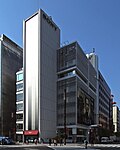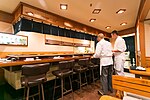Ginza Six
2017 establishments in JapanBuildings and structures in Chūō, TokyoGinzaJ. Front RetailingShopping malls established in 2017

Ginza Six is a luxury shopping complex located in the Ginza area of Tokyo, jointly developed by Mori Building Company, J. Front Retailing, Sumitomo Corporation and L Catterton Real Estate. The name Ginza Six or G Six reflects the building address in Ginza 6-chome as well as the desire to provide an exceptional "six-star" shopping experience.
Excerpt from the Wikipedia article Ginza Six (License: CC BY-SA 3.0, Authors, Images).Ginza Six
Circle 1, Chuo
Geographical coordinates (GPS) Address Nearby Places Show on map
Geographical coordinates (GPS)
| Latitude | Longitude |
|---|---|
| N 35.669569444444 ° | E 139.76408055556 ° |
Address
銀座
Circle 1
104-0041 Chuo
Japan
Open on Google Maps






